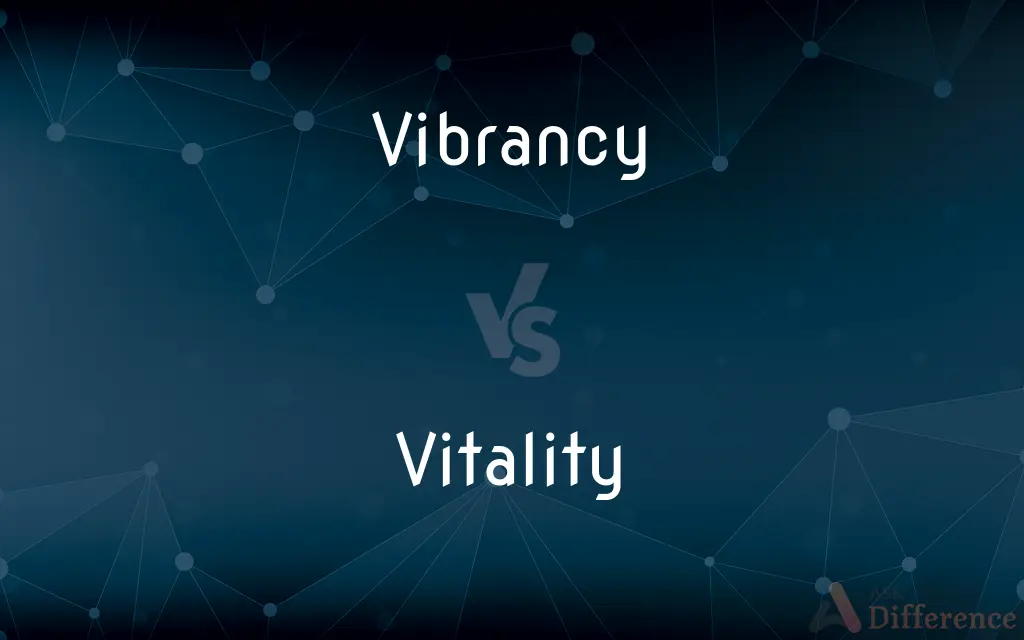Vibrancy vs. Vitality — What's the Difference?
Edited by Tayyaba Rehman — By Fiza Rafique — Updated on March 29, 2024
Vibrancy refers to the energy and enthusiasm in presentation or appearance, often colorful and lively, while vitality denotes the capacity for survival or the continuation of a meaningful or purposeful existence.

Difference Between Vibrancy and Vitality
Table of Contents
ADVERTISEMENT
Key Differences
Vibrancy is characterized by bright colors, energy, and liveliness, commonly associated with visual and sensory experiences that stimulate and captivate. On the other hand, vitality encompasses the broader concept of life, health, and vigor, often referring to the inner strength or capacity of an organism or entity to live and thrive.
While vibrancy is often used to describe the dynamic and spirited quality of an environment, artwork, or community, suggesting an aesthetic or atmospheric liveliness, vitality is more frequently associated with physical health, stamina, and the essential force sustaining life. Vibrancy, therefore, is about external expressions of energy and enthusiasm, whereas vitality focuses on the intrinsic capacity for growth, survival, and continuation.
Vibrancy can be transient, fluctuating with changes in environment, mood, or context, reflecting the immediate energy or spirit of a moment or place. Vitality, on the other hand, denotes a more enduring quality, essential to the very being of a living organism or system, indicating its ability to endure, adapt, and flourish over time.
In human contexts, vibrancy is often sought in experiences, spaces, and cultures, celebrated for its ability to inspire, uplift, and energize. Vitality, however, is pursued through health, well-being, and sustainability, crucial for a life of purpose and longevity.
The concept of vibrancy is invaluable in fields such as design, art, and urban planning, where the focus is on creating environments and experiences that are visually stimulating and emotionally engaging. Conversely, vitality is a central concern in biology, medicine, and wellness, where the goal is the maintenance or enhancement of life’s quality and duration.
ADVERTISEMENT
Comparison Chart
Definition
Energy and enthusiasm in appearance or spirit
Capacity for survival or meaningful existence
Primary Association
Aesthetic qualities, colors, and liveliness
Health, strength, and essential life force
Temporality
Can be transient and fluctuating
Indicates enduring quality and resilience
Application Fields
Design, art, urban planning
Biology, medicine, wellness
Human Focus
Inspiring and uplifting experiences
Health and sustainability for longevity
Compare with Definitions
Vibrancy
Bright and striking appearance.
Her vibrant personality is reflected in her colorful wardrobe.
Vitality
Physical or intellectual vigor; energy.
The debate was infused with her intellectual vitality.
Vibrancy
Liveliness and energy in color or spirit.
The vibrancy of the mural brought the entire room to life.
Vitality
The state of being strong and active; energy.
He was admired for his vitality even in old age.
Vibrancy
The quality of being full of energy and life.
The city's streets are known for their vibrancy.
Vitality
The power giving continuance of life, present in all living things.
Regular exercise improves vitality.
Vibrancy
Dynamic and spirited.
The festival was a display of cultural vibrancy.
Vitality
The capacity for survival or for the continuation of a meaningful existence.
The vitality of the ecosystem is at risk.
Vibrancy
Stimulating and captivating.
The vibrancy of the music energized the crowd.
Vitality
Essential for life or continued existence.
Water is vital for the vitality of these plants.
Vibrancy
Pulsing or throbbing with energy or activity
The vibrant streets of a big city.
Vitality
Vitality (from Middle French vitalité, from Latin vītālitās, from Latin vīta 'life') is the capacity to live, grow, or develop. More simply it is the property of having life.
Vibrancy
Vigorous, lively, and vital
"a vibrant group that challenged the ... system" (Philip Taubman).
Vitality
The state of being strong and active; energy
Changes that will give renewed vitality to our democracy
Vibrancy
Exhibiting or characterized by rapid, rhythmic movement back and forth or to and fro; vibrating.
Vitality
The capacity to live, grow, or develop
Plants that lost their vitality when badly pruned.
Vibrancy
Produced as a result of vibration; resonant or resounding
Vibrant voices.
Vitality
The characteristic, principle, or force that distinguishes living things from nonliving things.
Vibrancy
Relatively high on the scale of brightness
A vibrant hue.
Vitality
Physical or intellectual vigor; energy or liveliness.
Vibrancy
The quality of being vibrant.
Vitality
The capacity to endure
The vitality of an old tradition.
Vibrancy
The state of being vibrant; resonance.
Vitality
The capacity to live and develop.
Vibrancy
Having the character of a loud deep sound; the quality of being resonant
Vitality
Energy or vigour.
Vitality
That which distinguishes living from nonliving things; life, animateness.
Vitality
The quality or state of being vital; the principle of life; vital force; animation; as, the vitality of eggs or vegetable seeds; the vitality of an enterprise.
Vitality
An energetic style
Vitality
A healthy capacity for vigorous activity;
Jogging works off my excess energy
He seemed full of vim and vigor
Vitality
(biology) a hypothetical force (not physical or chemical) once thought by Henri Bergson to cause the evolution and development of organisms
Vitality
The property of being able to survive and grow;
The vitality of a seed
Common Curiosities
What is vibrancy?
Vibrancy refers to the quality of being full of energy and life, often associated with bright colors and liveliness.
Is vibrancy only related to visual experiences?
While vibrancy is often associated with visual experiences, it can also refer to any aspect of an environment or experience that is dynamic, spirited, and stimulating.
How do vibrancy and vitality differ in their application?
Vibrancy is primarily applied to aesthetics and sensory experiences, while vitality relates to physical health and the essential force of life.
Can an environment exhibit both vibrancy and vitality?
Yes, an environment can exhibit both vibrancy in its energetic and lively appearance and vitality through its sustainability and ability to support life.
How is vitality important to health?
Vitality is crucial to health as it encompasses the strength, energy, and capacity necessary for physical and mental well-being and longevity.
Can vibrancy affect one's sense of vitality?
Yes, being in vibrant environments or engaging with vibrant activities can positively influence one's sense of vitality, enhancing feelings of energy and liveliness.
What role does vitality play in wellness?
Vitality plays a central role in wellness, focusing on practices and lifestyles that promote health, energy, and the ability to thrive.
How does environmental vibrancy contribute to quality of life?
Environmental vibrancy contributes to quality of life by making spaces more engaging, enjoyable, and conducive to positive social and personal experiences.
What does vitality mean?
Vitality denotes the capacity for survival or the continuation of a meaningful or purposeful existence, emphasizing health and vigor.
Why is vibrancy important in urban planning?
Vibrancy is important in urban planning to create engaging, lively, and attractive spaces that stimulate social interaction and community well-being.
How do cultural expressions of vibrancy vary?
Cultural expressions of vibrancy vary widely, reflecting the unique aesthetics, traditions, and energies of different communities.
What measures can enhance personal vitality?
Enhancing personal vitality can involve balanced nutrition, regular physical activity, mental health care, and engagement in meaningful activities.
Can technology impact vibrancy and vitality?
Yes, technology can impact vibrancy by enhancing sensory experiences and vitality by improving access to health information and resources.
Why is vibrancy valued in art and culture?
Vibrancy is valued in art and culture for its ability to evoke emotions, stimulate the senses, and reflect the dynamism of human experience.
In what ways can vitality be assessed?
Vitality can be assessed through physical health indicators, levels of energy and activity, and the overall capacity for resilience and growth.
Share Your Discovery

Previous Comparison
Quick vs. Speedy
Next Comparison
Foxglove vs. HollyhockAuthor Spotlight
Written by
Fiza RafiqueFiza Rafique is a skilled content writer at AskDifference.com, where she meticulously refines and enhances written pieces. Drawing from her vast editorial expertise, Fiza ensures clarity, accuracy, and precision in every article. Passionate about language, she continually seeks to elevate the quality of content for readers worldwide.
Edited by
Tayyaba RehmanTayyaba Rehman is a distinguished writer, currently serving as a primary contributor to askdifference.com. As a researcher in semantics and etymology, Tayyaba's passion for the complexity of languages and their distinctions has found a perfect home on the platform. Tayyaba delves into the intricacies of language, distinguishing between commonly confused words and phrases, thereby providing clarity for readers worldwide.














































